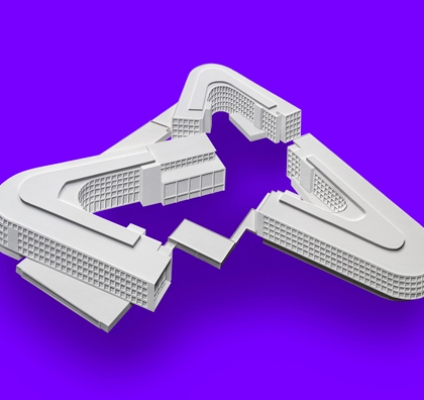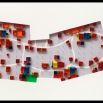Langlands & Bell: In this new series of art works we're looking at the new architecture of the internet giants which is developing as we speak. Huge new buildings are being commissioned by companies that only started 20, 30 or 40 years ago, often in spare rooms and garages. As they grew, they moved into banal business parks. But now they've become huge corporations and they're caught between expressing their success with iconic buildings like the huge new Apple HQ at Cupertino designed by Foster & Partners, or retaining the informality of the original campus ‘start-up’. The new Facebook HQ in Menlo Park is an example, although it's vast, it's quite understated. It's the world's largest open plan office floor raised in stilts, with a roof park. For its size it seems quite subdued, and low impact. The paradox is that they commissioned Frank Gehry to design it and Gehry is known for designing exuberant eye-catching landmarks!
HL: And why do you think there is that paradox, that coyness by the companies involved?
L&B: Maybe because the roles of these companies are still evolving and relatively undefined
they're shy about revealing their growing power and ambition.
Their rapid success is built on public acceptance of their original 'youthful idealism’, the novelty of
their innovation, the anarchic freedom of the early internet, and their aura of informality.
So for example, Steve Jobs only ever wore a black polo neck sweater with jeans and trainers,
and Mark Zuckerberg is a billionaire who attends business meetings in a T shirt.
However the question is often asked: what's the real role or function of these companies today,
are they educators, entertainment companies, advertising or media corporations, publishers,
news organizations, or retailers? Or are they just technology companies - which is what they say
they are? They're all of these, and more, but more importantly they're huge corporations creating
a new kind of global order that is extremely pervasive. They're re-shaping the culture, politics and
economies of every society on the planet comprehensively. Companies like Apple, Microsoft and
Facebook are establishing rules, systems, and orders that we have little option but to follow. These are just as determining as the physical architecture of buildings – or more so. So they may feel that if they start commissioning highly visible iconic buildings as well - like all powerful, commercial and political entities have done in the past - they may become a focus for discontent. Basically, monumental architecture does not really fit in with their public image, and at the very least this may inhibit their growth.
HL: So perhaps there is a disconnect between what they're saying and what they're actually offering? They say “we're making information accessible to everyone, everywhere”, but they are doing it in a way that is determined exclusively by them.
L&B: Well yes, it's the old Henry Ford thing multiplied exponentially: You can have any colour car
you want as long as it's black. You can have as much information as you like, as long as we
- supply it to you in the way we want. It's enabling and empowering, but at the same time very controlling and we are all captive.
HL: And I wonder if this disconnect continues in the physical architecture of the buildings. When these companies started out they really were accessible and free, but how accessible are they now, The Facebook sculpture you have made shows the world’s largest open plan office building: a single room 4 acres in size and the Apple headquarters is a completely circular building, a mile in circumference, where presumably the implication is of equality…
L&B: Yes, both buildings are spectacles of endless access. But of course they're not really unhindered, it depends on your position, who you are, and where you're looking at it from, and you always return to your starting point, it's an infinite loop! Apple won't even allow Foster to put the building he has designed for them on his own website.
HL: Precisely.
L&B: They want to convey that they're user friendly and accessible. The layouts of these buildings, which are routinely described as ‘campuses’, are apparently intended to foster spontaneous interactions and the serendipity of youthful creativity. The design of the Gates Foundation employs boomerang-like forms to symbolize communication and the movement of information in space.
HL: I wonder if you could elaborate a bit more about how you have chosen to display them, because they themselves are seemingly floating in space - devoid of contextual surroundings. Was this a conscious decision?
L&B: Yes it's intentional. We isolated them in order to focus on the most symbolic elements or revealing parts of the structure. Sometimes we're looking at the shape, or“object”, other times inside at the plan.
HL: But there is also a kind of anonymity here, it is non-autographic. You are presenting the factual data of the building without really inputting your own opinions.
L&B: We don't want or need to include our opinions. The building on its own is enough. By removing all the extraneous detail we're presenting it for contemplation...as a way in. So you are the person looking...at the places and the structures we all inhabit.
HL: And where does the choice of colour come from?
L&B: We select the colours intuitively to suit the subject and the shape and, by being isolated,
its identity is emphasised.
HL: I think that point about identity leads us to the architects these companies choose to work with. A lot of them are ‘starchitects', whereas others are more corporate. Do you think the choice of architect is a statement about these companies’ identity?
L&B: Undoubtedly, especially with Apple and Foster, who share a futuristic aesthetic approach, with a liking for sleek sophisticated technological design. Some of these companies clearly identify with certain architects. Maybe Gehry's anarchic exuberance appealed to Facebook, but the paradox is that the building he has designed is not a “crazy” gesture, it is actually quite discreet. Both of these architects are huge stars, but the Nvidia Headquarters is by Gensler, a more anonymous more corporate outfit. What all of them share though is a kind of “nostalgia for the future” design philosophy to evoke the impulse to explore new frontiers, quite Star Treck really.
HL: The desire to be pioneering and looking forward to a brighter world is something that brings in the Gates Foundation; they claim they want to eradicate the world of disease. Why have you included them?
- L&B: Well it's funded by Bill and Melinda Gates, so obviously it wouldn’t have existed without Microsoft, and if Microsoft disappears the Foundation will still exist. So they're aiming at posterity, to leave a legacy. This kind of philanthropy has a long history: Peabody, Mellon, Carnegie, Nobel - a manufacturer of gunpowder, an arms manufacturer basically - were all offsetting the implications of the vast wealth they had amassed, with ambitious charitable gestures, ‘giving something back’ as they say. This dichotomy has been evident throughout history, and it's a paradox echoed by the other internet companies: the entire roof of the Apple building is covered in solar panels, while the Facebook building has a green roof. This seems to indicate that both companies recognize the importance of the eco agenda and are committed to sustainability, but their business models are completely unsustainable. The Apple business model, like many today, is all about enforced obsolescence encouraging increased consumption of their products. Nothing is built to last, systems are not supported beyond about 5 years, and although we're drowning in defunct computers and mobile phones, more crucially it feels as though we are submitting to a kind of enforced amnesia as “the data” of our past is being progressively erased, or moved beyond our reach, by the persistent drive to market new products.
HL: ...whereas 30 years ago products were built to last, not to be immediately subsumed by the next model or operating system, but I guess this is what they call progress?
L&B: Maybe their accountants and shareholders call it progress.
HL: Lastly I wanted to ask you if this series of works is going to develop further? Are there other
buildings that you are thinking of looking at?
L&B: Yes, it's an ongoing project. We'll be exhibiting at the Ikon Gallery in Birmingham from
March – June next year and we're looking at the architecture of many other internet and
technology companies. As with the cathedrals and castles of the middle ages, the palaces and
gardens of the enlightenment, and the factories and railway stations of the industrial revolution,
one of the things we're exploring is whether this architecture is era defining - the architecture
of the twenty-first century, and whether architecture as a whole will still play this role in the
'Information Age'?
___________________________________________________________________________
Ben Langlands & Nikki Bell are artists based in London who have been collaborating since 1978.
Harry Laughland is an art historian based in London and Paris.
This text is an edited transcript of a conversation with Harry Laughland and Ben Langlands
& Nikki Bell published on the occasion of Infinite Loop the exhibition by Langlands & Bell
at Alan Cristea Gallery, London, 24 April – 3 June 2017.
Internet Giants : Masters of the Universe
an exhibition of new and recent sculpture by Langlands & Bell
Ikon Gallery, Birmingham : 21 March – 10 June 2018
@langlandsandbell
www.langlandsandbell.com

 Infinite Loop red, digital artwork by Richard Wilding - image courtesy Langlands & Bell and Alan Cristea Gallery, London.
">
Infinite Loop red, digital artwork by Richard Wilding - image courtesy Langlands & Bell and Alan Cristea Gallery, London.
"> Facebook Menlo Park, cropped, photo by Peter White - image courtesy Langlands & Bell and Alan Cristea Gallery, London.
">
Facebook Menlo Park, cropped, photo by Peter White - image courtesy Langlands & Bell and Alan Cristea Gallery, London.
"> Facebook Menlo Park, detail, photo by Peter White - image courtesy Langlands & Bell and Alan Cristea Gallery, London.
">
Facebook Menlo Park, detail, photo by Peter White - image courtesy Langlands & Bell and Alan Cristea Gallery, London.
">
 Apple Levitation peppermint, digital artwork by Richard Wilding - image courtesy Langlands & Bell and Alan Cristea Gallery, London.
">
Apple Levitation peppermint, digital artwork by Richard Wilding - image courtesy Langlands & Bell and Alan Cristea Gallery, London.
"> Apple Oblique cream, digital artwork by Richard Wilding - image courtesy Langlands & Bell and Alan Cristea Gallery, London.
">
Apple Oblique cream, digital artwork by Richard Wilding - image courtesy Langlands & Bell and Alan Cristea Gallery, London.
"> Apple Oblique teal, digital artwork by Richard Wilding - image courtesy Langlands & Bell and Alan Cristea Gallery, London.
">
Apple Oblique teal, digital artwork by Richard Wilding - image courtesy Langlands & Bell and Alan Cristea Gallery, London.
">
 Gates Foundation mauve, digital artwork by Richard Wilding - image courtesy Langlands & Bell and Alan Cristea Gallery, London.
">
Gates Foundation mauve, digital artwork by Richard Wilding - image courtesy Langlands & Bell and Alan Cristea Gallery, London.
"> IBM Beijing blue, digital artwork by Richard Wilding - image courtesy Langlands & Bell and Alan Cristea Gallery, London.
">
IBM Beijing blue, digital artwork by Richard Wilding - image courtesy Langlands & Bell and Alan Cristea Gallery, London.
"> IBM Beijing light grey, digital artwork by Richard Wilding - image courtesy Langlands & Bell and Alan Cristea Gallery, London.
">
IBM Beijing light grey, digital artwork by Richard Wilding - image courtesy Langlands & Bell and Alan Cristea Gallery, London.
">
 Nvidia orange 14, digital artwork by Richard Wilding - image courtesy Langlands & Bell and Alan Cristea Gallery, London.
">
Nvidia orange 14, digital artwork by Richard Wilding - image courtesy Langlands & Bell and Alan Cristea Gallery, London.
"> Apple Sunny Vale, cropped, photo by Peter White - image courtesy Langlands & Bell and Alan Cristea Gallery, London.
">
Apple Sunny Vale, cropped, photo by Peter White - image courtesy Langlands & Bell and Alan Cristea Gallery, London.
"> Langlands & Bell in the studio - photo Bran Symondson, image courtesy Langlands & Bell and Alan Cristea Gallery, London.
">
Langlands & Bell in the studio - photo Bran Symondson, image courtesy Langlands & Bell and Alan Cristea Gallery, London.
">

 Infinite Loop red, digital artwork by Richard Wilding - image courtesy Langlands & Bell and Alan Cristea Gallery, London.
">
Infinite Loop red, digital artwork by Richard Wilding - image courtesy Langlands & Bell and Alan Cristea Gallery, London.
"> Facebook Menlo Park, cropped, photo by Peter White - image courtesy Langlands & Bell and Alan Cristea Gallery, London.
">
Facebook Menlo Park, cropped, photo by Peter White - image courtesy Langlands & Bell and Alan Cristea Gallery, London.
"> Facebook Menlo Park, detail, photo by Peter White - image courtesy Langlands & Bell and Alan Cristea Gallery, London.
">
Facebook Menlo Park, detail, photo by Peter White - image courtesy Langlands & Bell and Alan Cristea Gallery, London.
">
 Apple Levitation peppermint, digital artwork by Richard Wilding - image courtesy Langlands & Bell and Alan Cristea Gallery, London.
">
Apple Levitation peppermint, digital artwork by Richard Wilding - image courtesy Langlands & Bell and Alan Cristea Gallery, London.
"> Apple Oblique cream, digital artwork by Richard Wilding - image courtesy Langlands & Bell and Alan Cristea Gallery, London.
">
Apple Oblique cream, digital artwork by Richard Wilding - image courtesy Langlands & Bell and Alan Cristea Gallery, London.
"> Apple Oblique teal, digital artwork by Richard Wilding - image courtesy Langlands & Bell and Alan Cristea Gallery, London.
">
Apple Oblique teal, digital artwork by Richard Wilding - image courtesy Langlands & Bell and Alan Cristea Gallery, London.
">
 Gates Foundation mauve, digital artwork by Richard Wilding - image courtesy Langlands & Bell and Alan Cristea Gallery, London.
">
Gates Foundation mauve, digital artwork by Richard Wilding - image courtesy Langlands & Bell and Alan Cristea Gallery, London.
"> IBM Beijing blue, digital artwork by Richard Wilding - image courtesy Langlands & Bell and Alan Cristea Gallery, London.
">
IBM Beijing blue, digital artwork by Richard Wilding - image courtesy Langlands & Bell and Alan Cristea Gallery, London.
"> IBM Beijing light grey, digital artwork by Richard Wilding - image courtesy Langlands & Bell and Alan Cristea Gallery, London.
">
IBM Beijing light grey, digital artwork by Richard Wilding - image courtesy Langlands & Bell and Alan Cristea Gallery, London.
">
 Nvidia orange 14, digital artwork by Richard Wilding - image courtesy Langlands & Bell and Alan Cristea Gallery, London.
">
Nvidia orange 14, digital artwork by Richard Wilding - image courtesy Langlands & Bell and Alan Cristea Gallery, London.
"> Apple Sunny Vale, cropped, photo by Peter White - image courtesy Langlands & Bell and Alan Cristea Gallery, London.
">
Apple Sunny Vale, cropped, photo by Peter White - image courtesy Langlands & Bell and Alan Cristea Gallery, London.
"> Langlands & Bell in the studio - photo Bran Symondson, image courtesy Langlands & Bell and Alan Cristea Gallery, London.
">
Langlands & Bell in the studio - photo Bran Symondson, image courtesy Langlands & Bell and Alan Cristea Gallery, London.
">






















